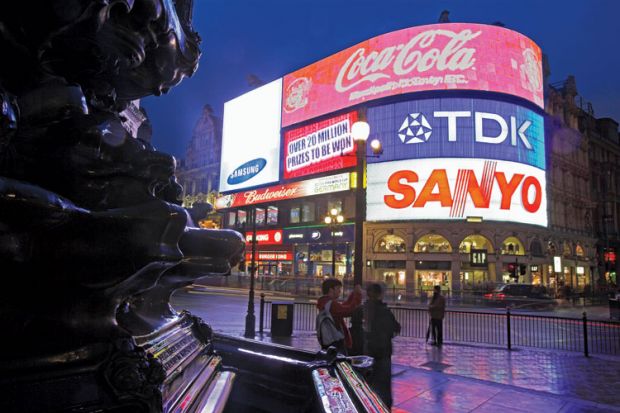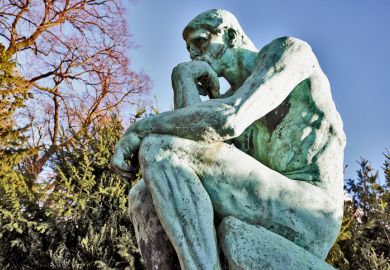From comedy in social media to art in an age of austerity and plaintive politicians to the continuing relevance of Freud, this year’s Inside Out Festival offers a typically challenging and wide-ranging feast of discussions, performances, concerts and exhibitions.
Taking place in campuses and other venues all over London from 19 to 24 October, it is curated by the Culture Capital Exchange in association with Times Higher Education and designed to celebrate the impressively tight links between the city’s universities and its cultural life.
Dominic Johnson, senior lecturer in drama at Queen Mary University of London (QMUL), believes that standard accounts of performance art in the 1970s and 1980s ignore some of the most interesting figures. So he has interviewed 12 of them in his new book, The Art of Living: An Oral History of Performance Art.
In a discussion taking place in the 1830s chapel at King’s College London (20 October), he will set out the central themes. Expect dramatic interventions from former Warhol superstar Penny Arcade and Anne Bean, founder of the 1970s band Moody and the Menstruators.
The Inside Out Festival has also long organised walks uncovering unexpected corners of London life and history. After a revelatory freezing night walk through Soho last year, Nadia Valman, reader in English at QMUL, is offering “a walking guide to the Victorian East End” (20 October).
Step back in time
This will set out through Spitalfields in the footsteps of Israel Zangwill, whose sensational 1892 novel Children of the Ghetto opened up a whole new world to many of his readers. Those who take part will also get a chance to download Dr Valman’s new app, “Zangwill’s Spitalfields”, which incorporates photographs, documents and digitised objects from the Jewish Museum evocative of immigrant life in the late 19th century.
Meanwhile, Joanne Entwistle, senior lecturer in culture and creative industries at King’s College London, will join forces with the Configuring Light team at the London School of Economics for “Light Talk: Night Walk” (21 October). This will reveal how lighting technology – from the gaslights of Pimlico to the constant neon spectacle of Piccadilly Circus – has done much to create the identity of the modern city and inform our sense of space.
A “promenade performance” at the London Museum of Water and Steam (20 October), co-organised by the London College of Music at the University of West London, also examines the dramatic impact of technological change, specifically the power and “pandemonium” unleashed by the Industrial Revolution.
In addition, Jeremy Strong, professor of literature and film at the University of West London, aims to use a tour to help identify for people some of the famous institutions of the area known as “clubland” near Westminster.
He said that a notable characteristic of the area was “the absence of identifying markers. Some of the larger premises, purpose-built on Pall Mall in the 19th or 20th centuries, may extend to a flag or modest brass plaque, but generally discretion is the guiding principle…needing to ask is a consistently reliable indicator that one is probably intended to remain outside.”
So in a tour taking walkers from Boodle’s to the East India Club by way of White’s, The Carlton, The Reform and The Athenaeum (22 October) – but unfortunately not including entry to any of them – he will consider both their significance in British life and the more or less thinly disguised variants to be found in the fiction of Arthur Conan Doyle, P. G. Wodehouse and Ian Fleming.
Finally, to mark the publication of his book Weeping Britannia: Portrait of a Nation in Tears, Thomas Dixon, reader in history at QMUL, will take part in a panel event (23 October) where he plans to present “a short introductory talk about tearful politicians in British history”.
"I’ll go right back to Cromwell and Charles I, and mention the most notable bout of weeping in the House of Commons” such as “Charles James Fox bursting into tears in May 1791 when his views of the French Revolution were ridiculed by his friend Edmund Burke”.
This will lead into his distinctive interpretation of the career of Margaret Thatcher, “whose public image became increasingly macho and (according to her critics) unfeeling in the course of her premiership. Hilary Mantel’s recently published short story about the assassination of Thatcher includes the narrator speculating that she was congenitally unable to cry. But, in fact, Thatcher was responsible for helping to make British politics much more personal and more emotional.”
Also taking up issues highly topical since the rise to the Labour Party leadership of Jeremy Corbyn will be Patrick Diamond, lecturer in public policy at QMUL, who may well draw on his experience as a former Labour policy adviser as he considers today’s “enormous emphasis on the apparent ‘authenticity’ of politicians”, when many “have turned to very public gestures of emotion as a way of projecting who they ‘really’ are”.
后记
Print headline: ‘Clubland’ rambling is food for the brain




